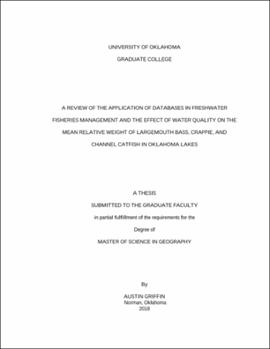| dc.contributor.advisor | Hoagland, Bruce | |
| dc.contributor.author | Griffin, Austin | |
| dc.contributor.author | Hoagland, Bruce | |
| dc.contributor.author | Kuklinski, Kurt | |
| dc.date.accessioned | 2018-07-31T14:25:44Z | |
| dc.date.available | 2018-07-31T14:25:44Z | |
| dc.date.issued | 2018-05-12 | |
| dc.identifier.uri | https://hdl.handle.net/11244/301323 | |
| dc.description.abstract | The subject of this thesis is the development and use of databases for use in fisheries management. The thesis consists of two chapters. The first is a literature review of fisheries databases and an overview of my work as a graduate research assistant with the Oklahoma Biological Survey and Oklahoma Fisheries Research Laboratory (OFRL) of the Oklahoma Department of Wildlife Conservation.
The Standard Sampling Protocol (SSP) is at the core of both chapters. In chapter 1, I reviewed the fisheries database literature to aid in the development of the SSP Database and emphasize some of the issues that commonly occur with database development and application. This information guided me in the development of a relational database for the SSP data. The resulting database includes approximately 1.6 million records for 150 fish species in Oklahoma. The database schema consists of five tables: Abiotic, Biotic, SSP Species List, OBIS Taxonomy, and OWRB Lake Data.
Chapter 2 employed the SSP database to determine if water quality parameters in 108 Oklahoma lakes influenced the relative weights of largemouth bass (Micropterus salmoides), crappie (Pomoxis annularis and Pomoxis nigromaculatus), and channel catfish (Ictalurus punctatus). Discriminant analysis of eight water quality parameters resulted in the classification of said lakes into six classes. Mean relative weights for largemouth bass, crappie, and catfish ranged from 89.84-99.17, 91.99-98.17, and 86.90-94.01 respectively. Salinity, which was the most important explanatory variable in lake classification, ranged from 0.04-0.63 ppt among the six classes. This information could prove useful to the fisheries managers of Oklahoma by reclassifying similar lakes regardless of management region, allowing for a different perspective on management practices. | en_US |
| dc.language | en_US | en_US |
| dc.subject | fisheries, relative weight, relational database, water quality | en_US |
| dc.title | A review of the application of databases in freshwater fisheries management and the effect of water quality on the mean relative weight of largemouth bass, crappie, and channel catfish in Oklahoma lakes. | en_US |
| dc.contributor.committeeMember | Loraamm, Rebecca | |
| dc.contributor.committeeMember | Neeson, Thomas | |
| dc.date.manuscript | 2018-07-27 | |
| dc.thesis.degree | Master of Science | en_US |
| ou.group | College of Atmospheric & Geographic Sciences::Department of Geography and Environmental Sustainability | en_US |
| shareok.orcid | 0000-0003-2019-7616 | en_US |
